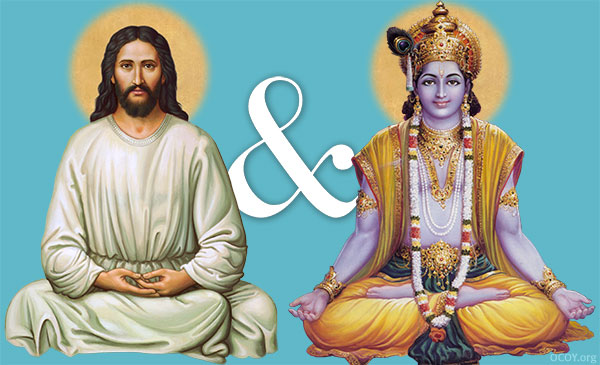
Q: Would you explain the incarnations of the Hindu faith and how we should reconcile Krishna and Jesus?
There are two views about divine incarnations in India.
The most common is the idea that God incarnates and lives in a physical body. Some say, however, that the incarnation is in a chinmaya body, a body formed of consciousness and not vibratory matter, that such an incarnation is just an appearance, and a play of consciousness. But since everything is a play of consciousness, that is not saying much. Whichever is believed, physical (anumaya) or chinmaya, this is the view of the scriptures known as Puranas.
The yoga/sankhya view of incarnation
The other view is that of the yogis, those who ascribe to the Yoga Philosophy or Yoga Darshan of Patanjali, which is itself based on the Sankhya Philosophy attributed to the sage Kapila. According to this view, if a person has evolved through all the levels of relative existence and attained the transcendental state of perfect liberation (moksha) and entered into total union with Brahman, the Supreme Consciousness, and elects to return to any of the levels of relative existence, including that of earth, to help others attain liberation, that person, when he incarnates, is an avatar, an incarnation of God.
As it was said of Jesus: “In him dwells all the fullness of the Godhead bodily” (Colossians 2:9). Since the individual spirit (atman) and the Supreme Spirit (Paramatman) are one in the avatar’s bodily vehicle, we can say that God is incarnate in that body. Such a being is truly an intermediary between God and humanity.
The body is the vehicle of the liberated being, a siddha, and the siddha is himself the vehicle of God. As the prophet said: “Behold, the virgin shall be with child, and bear a Son, and they shall call His name Immanuel, which is translated, ‘God with us’” (Matthew 1:23). When we speak with an avatar we are speaking with God who speaks back to us through the avatar–not like through a telephone or a medium, but through the illuminated consciousness of the avatar.
Supernatural births
Is a supernatural conception and birth a mark of an avatar? This is a question I have not come across in the Indian scriptures. However: Rama, Buddha, the Virgin Mary, Jesus, Ramakrishna and Anandamayi Ma were said to have such conceptions and to have absolutely painless births: they just appeared outside the mother’s body rather than being born in the usual manner. Further, they had full consciousness from the very moment of their birth.
Why would a supernatural conception be necessary? Perhaps because the kind of body for a liberated being to incarnate in needs to be of a higher order than that produced by human intercourse. When we realize that the body of an infant comes from the body of the mother, but its blood comes exclusively from the father, then the blood of an avatar would actually be a spiritual or divine manifestation. It might be speculated that this is why God could be called the Father of an avatar.
Naturally, there is no proof of these supernatural conceptions and births because essentially they were spiritual, not physical, events, though testimony exists from witnesses of both the conceptions and births.
Krishna and Jesus
There is no need for a reconciliation of the avatar of Krishna and Jesus unless someone believes that Jesus is unique in supernatural conception and birth. But that is a purely personal matter of opinion and “faith,” and what does that really affect in the universe? You cannot argue or even discuss these things intelligently with bigots.
But what about us?
But this thing we must come to know: Since we are all one with God, waves on the sea of Divine Being, in a sense we are all incarnations of God in actuality (not just in potential), and we have come into this world to liberate our consciousness into the realization and manifestation of that eternal reality.
As Krishna said to Arjuna: “Therefore be a yogi” (Bhagavad Gita 6:46).







